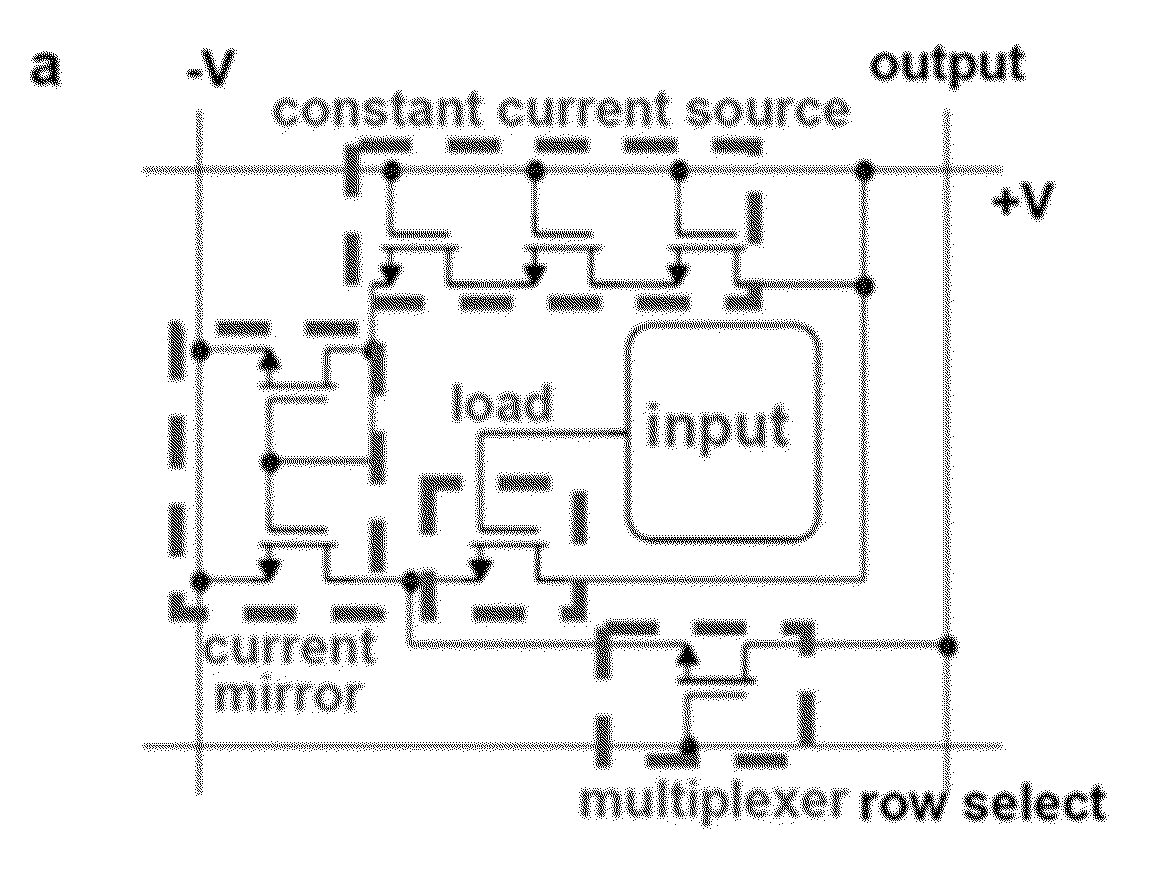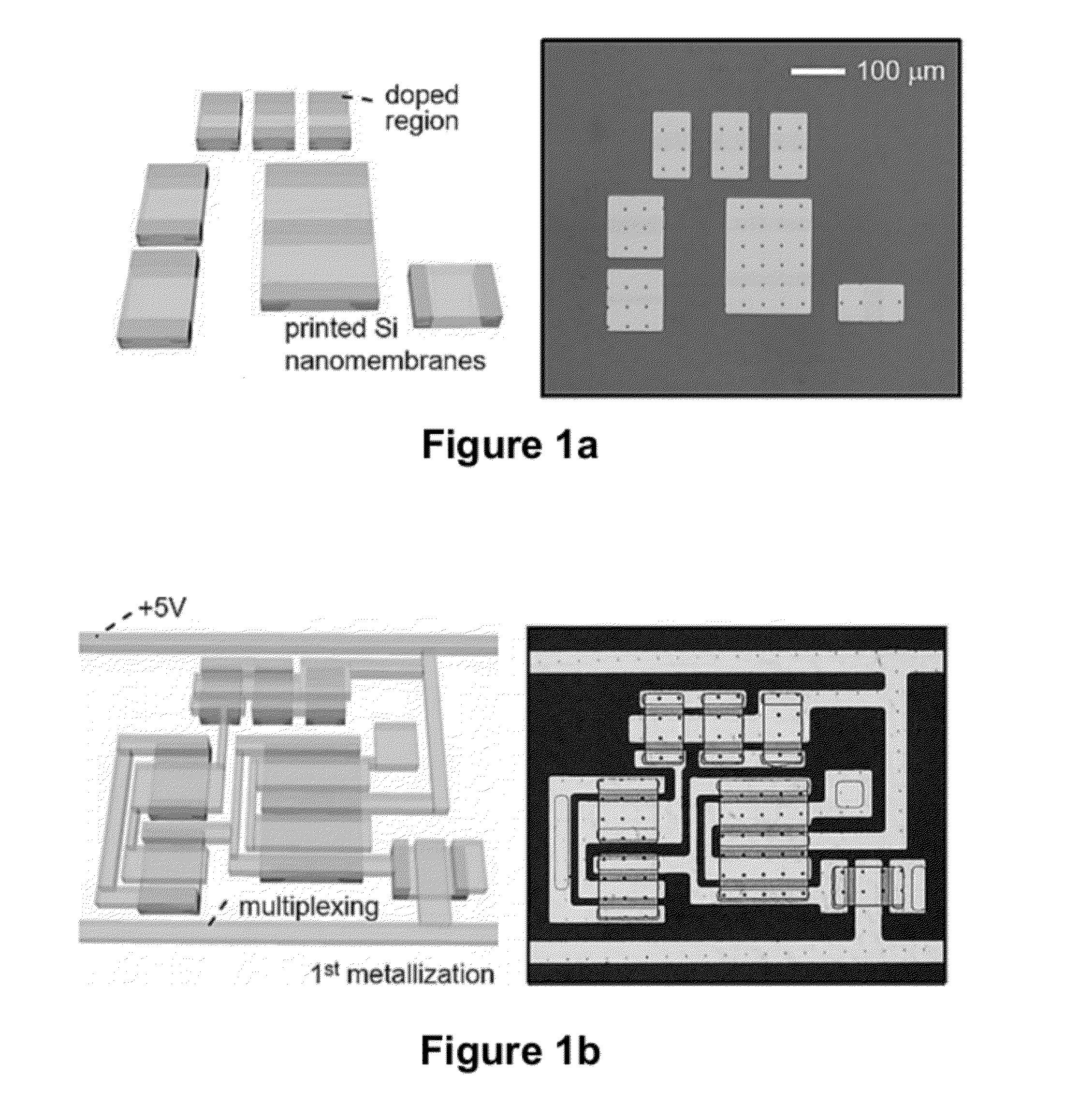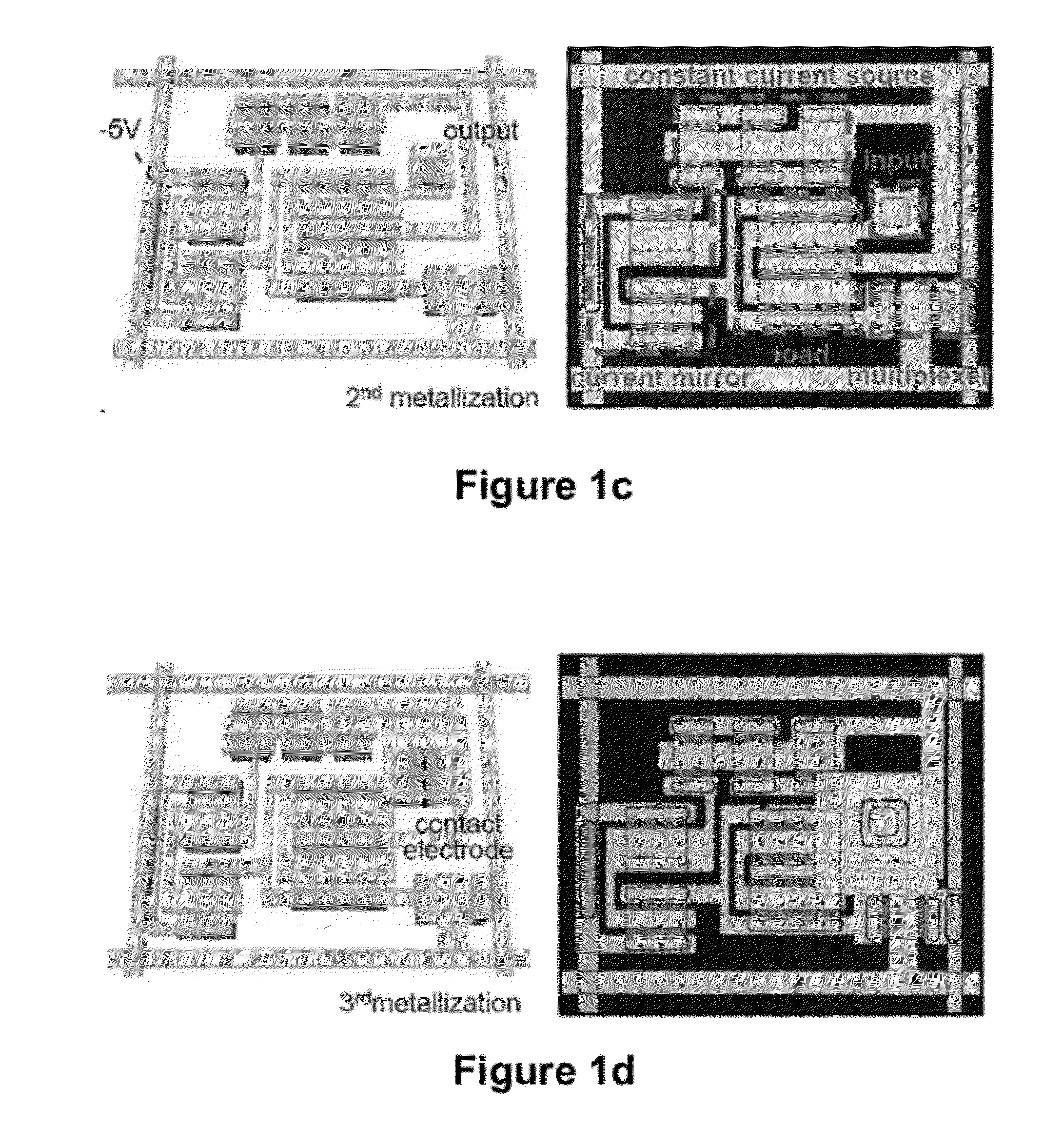[0013]The materials, physical dimensions and mechanical properties of the device, and components thereof, are selected in some embodiments to provide complete or partial electronic, optical, chemical and / or
thermal isolation of the device from the tissue and / or biological environment useful for avoiding damage of the tissue during use. In an embodiment, for example, the
barrier layer and the flexible or stretchable substrate limit a net leakage current from the
electronic circuit to an amount which does not adversely affect the tissue. In an embodiment, for example, the
barrier layer and the flexible or stretchable substrate limits
heat transfer from the
electronic circuit to the tissue in the biological environment to an amount that does not adversely affect the tissue in the biological environment.
[0017]The invention provides devices having physical and chemical properties useful for a wide range of biomedical applications including
cardiac monitoring, sensing and actuation of
brain tissue, vascular therapies and
skin mounted sensing. In an embodiment, for example, the substrate, the
electronic circuit and the
barrier layer provide a net
bending stiffness of the device less than or equal to 1×108 GPa μm4, optionally for some applications less than or equal to 1×107 GPa μm4, and optionally for some applications less than or equal to 1×106 GPa μm4. In an embodiment, for example, the substrate, the electronic circuit and the barrier layer provide a net
bending stiffness of the device selected over the range of 1×108 GPa μm4-1×105 GPa μm4, and optionally for some applications selected over the range of 1×107 GPa μm4-1×105 GPa μm4, and optionally for some applications selected over the range of 1×106 GPa μm4-1×105 GPa μm4. In an embodiment, for example, the substrate, the electronic circuit and the barrier layer provide a net
flexural rigidity of the device less than or equal to 1×10−4 Nm, and optionally for some embodiments less than or equal to 1×10−5 Nm. In an embodiment, for example, the substrate, the electronic circuit and the barrier layer provide a net
flexural rigidity of the device selected from the range of 1×10−4 Nm to 1×10−7 Nm, and optionally for some applications device selected from the range of 1×10−5 Nm to 1×10−7 Nm. For certain embodiments, devices of this aspect have and / or are capable of having a bending
radius for all and / or portions of the device of 100 μm. For example, devices of this aspect can adopt a
radius of curvature of 100 μm without undergoing damage to the device or device components, such as mechanical fracture,
device failure or interruption of electrical interconnections.
[0026]In some embodiments, the device of the invention comprises a substrate having one or more microstructured and / or nanostructured features, including recessed features, relief (e.g. raised) features, openings, passages and / or channels. In an embodiment, at least a portion of, and optionally all of, the electronic circuit component of the device is supported by a flexible or stretchable substrate having a mesh structure. Use of a substrate having a mesh structure is beneficial in the invention for providing a structurally supporting layer allowing for efficient handling and administration of the device, while at the same time providing mechanical properties (e.g., flexibility, deformability, bendability, stretchability, etc.) useful for establishing conformal contact with the
target tissue. In an embodiment, for example, a mesh structure refers to a layer or other
structural component that occupies a portion of, but not all, the foot print area of the device, for example, occupying a portion of, but not all of, the area of the device that interfaces the
target tissue. In an embodiment, for example, the foot print area of the device is an area corresponding to the perimeter of the device that establishes the interface with a target tissue, and the mesh structure of the substrate occupies a portion, but not all of the, foot print area. Mesh structures in some embodiments, occupy 75% or less than the foot print area and / or tissue interface area of the device, and optionally 50% or less than the foot print area and / or tissue interface area; and optionally 25% or less than the foot print area and / or tissue interface area of the device. In an embodiment, for example, the substrate has a mesh structure that is a lattice structure, a perforated structure or a
tentacle structure. In an embodiment, for example, the substrate is a mesh structure having structural regions at least partially supporting, or optionally in physical contact with, one or more of the components of the electronic circuit, such as inorganic
semiconductor components or electrodes, wherein structural regions of the substrate are separated from each other by voids,
cut outs or other openings where the substrate is not present. In such embodiments, therefore, the presence of the void regions,
cut outs or other openings provides a mesh structured substrate occupying less than the foot print area of the device. In an embodiment, for example, the substrate having a mesh structure is a discontinuous layer, as opposed to a continuous layer, such as a continuous film or sheet.
[0030]In an embodiment, for example, the flexible or stretchable electronic circuit comprises one or more flexible or stretchable inorganic
semiconductor structures. In an embodiment, for example, the flexible or stretchable inorganic
semiconductor structures of the electronic circuit component comprise a single crystalline inorganic semiconductor, such as single
crystalline silicon or a single crystalline iii-v
semiconductor structure. To provide useful flexibility in some embodiments, the semiconductor structures of the electronic circuit of the invention are thin semiconductor structures. In an embodiment, for example, the flexible or stretchable inorganic semiconductor structures have an average thickness less than or equal to 500 microns, optionally for some applications less than or equal to 100 microns, optionally for some applications less than or equal to 10 microns, optionally for some applications less than or equal to 1 micron, and optionally for some applications less than or equal to 500 nanometers. In an embodiment, for example, the flexible or stretchable inorganic semiconductor structures have an average thickness selected from the range of 100 nanometers to 1000 microns, optionally for some embodiments selected from the range of 500 nm to 500 microns, optionally for some embodiments selected from the range of 1 micron to 100 microns. In an embodiment, for example, the flexible or stretchable inorganic semiconductor structures have an average thickness selected from the range of 250 nanometers to 100 microns. In an embodiment, for example, the flexible or stretchable inorganic semiconductor structures are ultrathin structures. In an embodiment, for example, each of the flexible or stretchable inorganic semiconductor structures has a net
flexural rigidity less than or equal to less than or equal to 1×10−4 Nm. In an embodiment, for example, each of the flexible or stretchable inorganic semiconductor structures has a net
bending stiffness less than or equal to 1×108 GPa μm4, optionally for some applications less than or equal to 1×107 GPa μm4, and optionally for some applications less than or equal to 1×106 GPa μm4. In an embodiment, for example, each of the flexible or stretchable inorganic semiconductor structures is independently a flexible or stretchable semiconductor nanoribbon, semiconductor membrane, semiconductor
nanowire or any combination of these. In an embodiment, for example, the flexible or stretchable inorganic semiconductor structures are assembled on the flexible or stretchable substrate via a
transfer printing technique, such as
dry transfer contact printing and / or
transfer printing process using an elastomeric transfer device.
[0042]In some embodiments, barrier
layers and flexible or stretchable substrates limit a net leakage current from the electronic device to an amount which does not adversely affect a tissue in a biological environment. Barrier
layers of the invention include
moisture barriers. In one embodiment, the barrier layer is configured to limit a net leakage current from the electronic device to the biological environment to less than 10 μA, optionally for some applications less than 5 μA and optionally for some applications less than 1 μA, and optionally for some applications less than 0.1 μA. In some embodiments, the barrier layer prevents leakage current from being concentrated to small areas so to prevent
tissue damage caused by current leakage from the device. In an embodiment, for example, the barrier layer is configured to limit leakage current from the device to the biological environment to 0.1 μA / cm2; less, and for some applications 0.01 μA / cm2 or less, and for some applications 0.001 μA / cm2 or less. In some embodiments, barrier
layers of the invention have an electrical resistivity of 1014 Ω·m or greater, for example an electrical resistivity selected over the range of 1015 to 1017 Ω·m. In some embodiments, the barrier layer prevents the rate at which charge is leaked from the electronic device; for example, one barrier layer embodiment limits electrical
discharge from a device to 10 μC or less over a period of 1 second. In some embodiments, the barrier layer limits leakage current or average leakage current from the device to 10 μA or less or 5 μA or less over a long period of time, such as 3 hours or more or 5 hours or more.
[0062]In an aspect, the invention provides a device for
interfacing with a tissue in a biological environment, the device comprising: (1) a flexible or stretchable substrate; (2) a stretchable or flexible array of light emitting diodes comprising a plurality of light emitting diodes in electrical communication with a plurality of stretchable or flexible electrical interconnects, the stretchable or flexible array of light emitting diodes supported by the flexible or stretchable substrate; and (3) a barrier layer encapsulating at least a portion of the stretchable or flexible array of light emitting diodes to limit a net leakage current from the stretchable or flexible array of light emitting diodes to the tissue to an amount that does not adversely affect the tissue; wherein the flexible or stretchable substrate, stretchable or flexible array of light emitting diodes and the barrier layer provide a net bending stiffness of the device low enough that the device establishes conformal contact with the tissue in the biological environment. In an embodiment, the device of this aspect is an implantable or
skin mounted array of light emitting diodes. In an embodiment, for example, the stretchable or flexible array of light emitting diodes comprises a multilayer structure comprising a plurality of individually encapsulated
LED array layers provided in a multilayer stacked geometry, for example, wherein 2 to 50 individually encapsulated
LED array layers provided in a multilayer stacked geometry.
 Login to View More
Login to View More  Login to View More
Login to View More 


